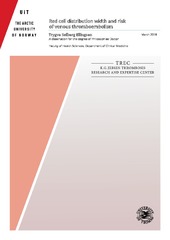Red cell distribution width and risk of venous thromboembolism
Permanent link
https://hdl.handle.net/10037/12848View/
thesis (PDF)
Paper II: Ellingsen, T.S, Lappegård, J., Ueland, T., Aukrust, P., Brækkan, S.K. & Hansen, J.B. (2018). Plasma hepcidin is associated with future risk of venous thromboembolism. Publishers version available in Blood advances,2:1194-1197.. (PDF)
Paper III: Ellingsen, T.S, Lappegård, J., Skjelbakken, T., Brækkan, S.K. & Hansen, J.B. (2015). Impact of red cell distribution width on future risk of cancer and all-cause mortality among cancer patients – the Tromsø Study. Obtained from the Haematologica Journal website http://www.haematologica.org, available at Haematologica, 100(10), e387-e389. (PDF)
Paper IV: Ellingsen, T.S, Lappegård, J., Skjelbakken, T., Mathiesen, E.B., Njølstad, I., Brækkan, S.K. & Hansen, J.B. (2018). The association between red cell distribution width and venous thromboembolism is not explained by myocardial infarction, stroke, or cancer. Also available in Research and Practice in Thrombosis and Haemostasis, 2(2), 327-333. (PDF)
Date
2018-06-11Type
Doctoral thesisDoktorgradsavhandling
Author
Ellingsen, Trygve SølbergAbstract
Venous thromboembolism (VTE) is a collective term for deep vein thrombosis and pulmonary embolism. VTE is the third most common cardiovascular disease, causing significant morbidity and mortality. The incidence of VTE has been stable or slightly increasing during the last decades, affecting 1-2 per 1000 individuals each year. Up to half of all VTE patients have no obvious cause of the disease. Thus, identifying novel biomarkers and unraveling underlying disease mechanisms might help diminish the health burden of VTE. Red cell distribution width (RDW) is a measure of the variability of size of the circulating red blood cells. RDW increase due to various conditions that alter the bone marrow’s production of red blood cells, such as iron deficiency. Recent years, RDW has been associated with risk of several diseases. The first aim of this thesis was to investigate whether RDW is associated with future risk of VTE and mortality among VTE patients. Secondly, we aimed to investigate whether the association could be explained by underlying iron deficiency or intermediate development of other diseases.
All papers in this thesis use data from the Tromsø Study, a large population-based cohort study. Our study populations were recruited from the fourth survey. For paper I, subjects were followed from date of inclusion in 1994/95 through January 1, 2012. In paper III and IV, study participants were followed from date of inclusion through December 31, 2010. Paper II is a nested case-control study with cases and controls selected among participants in Tromsø 4. Validated events of VTE, cancer, myocardial infarction (MI) and stroke were registered throughout the study periods.
We found that RDW was associated with future risk of VTE and all-cause mortality among VTE-patients. The association could not be explained by underlying iron deficiency. Further, RDW was associated with future risk of cancer, but intermediate development of cancer, stroke or MI did not explain the association between RDW and VTE. Venøs blodpropp eller venøs tromboembolisme (VTE) er en fellesbetegnelse på tilstandene dyp venetrombose og lungeemboli. VTE er verdens tredje vanligste hjerte- og karsykdom, og forårsaker betydelig morbiditet og mortalitet. Til tross for økt fokus på forebygging, har forekomsten vært stabil eller økende de siste tiårene. Hvert år rammes 1-2 av 1000 personer, og halvparten av de rammede har ingen åpenbar årsak. Nye bio- og risikomarkører kan bidra til bedre forståelse og forebygging av sykdommen, og kan dermed redusere de helsemessige konsekvensene. Graden av variasjon i størrelse på de røde blodcellene kan kvantifiseres som «Red Cell distribution Width» (RDW). RDW kan øke som en følge av ulike tilstander som påvirker beinmargens produksjon av røde blodceller, som for eksempel jernmangel. De siste årene har man funnet en sammenheng mellom RDW og risiko for flere sykdommer. Formålet med denne avhandlingen var å undersøke om RDW kan forutsi fremtidig risiko for VTE, samt dødelighet blant VTE-pasienter. Videre ønsket vi å undersøke om bakenforliggende jernmangel eller utvikling av andre sykdommer kunne forklare sammenhengen.
Alle artiklene i avhandlingen er basert på Tromsøundersøkelsen, som er en stor kohortestudie. Vi har benyttet data fra den fjerde undersøkelsen (Tromsø 4), som ble gjennomført i 1994-95. I den første artikkelen ble studiedeltakerne fulgt fra studiestart til og med 1. januar 2012. I den tredje og fjerde artikkelen ble deltakerne fulgt til og med 31. desember 2010. Den andre artikkelen er en nestet kasus-kontroll-studie med deltakere rekruttert fra Tromsø 4. Alle tilfeller av VTE, hjerteinfarkt, slag og kreft ble registret og validert gjennom studieperiodene.
Vi fant en sammenheng mellom høy RDW og økt risiko for fremtidig VTE, samt risiko for dødelighet blant VTE-pasienter. Sammenhengen kom ikke som en følge av jernmangel. Vi fant også en sammenheng mellom høy RDW og risiko for kreft, men hverken utvikling av kreft, hjerneslag eller hjerteinfarkt kunne forklare sammenhengen mellom RDW og VTE.
Description
Paper I of the thesis is not available in Munin.
Ellingsen, T.S., Lappegård, J., Skjelbakken, T., Brækkan, S.K. & Hansen, J.B. (2015). Red cell distribution width is associated with incident venous thromboembolism (VTE) and case-fatality after VTE in a general population. The manuscript version of this paper is available in Munin at http://hdl.handle.net/10037/7364.
Ellingsen, T.S., Lappegård, J., Skjelbakken, T., Brækkan, S.K. & Hansen, J.B. (2015). Red cell distribution width is associated with incident venous thromboembolism (VTE) and case-fatality after VTE in a general population. The manuscript version of this paper is available in Munin at http://hdl.handle.net/10037/7364.
Publisher
UiT The Arctic University of NorwayUiT Norges arktiske universitet
Metadata
Show full item recordCollections
Copyright 2018 The Author(s)
The following license file are associated with this item:


 English
English norsk
norsk
